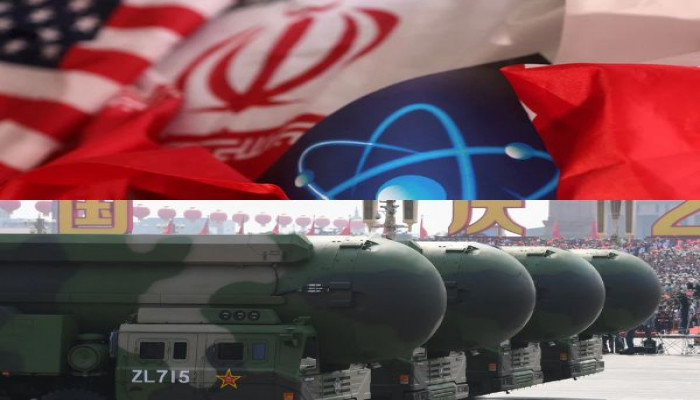China's nuclear stockpile touches 600 warheads: SIPRI Report
- In Reports
- 06:42 PM, Jun 16, 2025
- Myind Staff
China added 100 warheads in 2023 and 2024 that pushed its nuclear stockpile to at least 600, said an estimate by international security think tank SIPRI, warning of the emergence of a dangerous new arms race. Stockholm International Peace Research Institute (SIPRI) rolled out its yearly report on the state of armaments, disarmament, and international security on Monday.
SIPRI Yearbook 2025 found that a dangerous new nuclear arms race had emerged at a time when arms control regimes were severely weakened.
Nearly all of the nine nuclear-armed states—the United States, Russia, the United Kingdom, France, China, India, Pakistan, North Korea, and Israel—continued intensive nuclear modernisation programs in 2024 by upgrading existing weapons and adding newer versions, according to the report.
SIPRI Director Dan Smith warned about the challenges facing nuclear arms control and the possibility of a new nuclear arms race.
According to Smith, “China is increasing its nuclear force steadily,” and he added that the country could reach 1,000 warheads in seven or eight years.
Of the total global inventory of an estimated 12,241 warheads in January 2025, about 9,614 were in military stockpiles for potential use. An estimated 3,912 of these warheads were deployed with missiles and aircraft, and the rest were kept in central storage.
Around 2,100 of the deployed warheads remained in a state of high operational alert on ballistic missiles.
Almost all of these warheads belonged to Russia or the United States, but according to the SIPRI report, China may now keep some warheads on missiles during peacetime.
China expanded its nuclear arsenal faster than any other nation, adding roughly 100 new warheads each year since 2023.
By January 2025, China had completed or was close to completing around 350 new ICBM silos in three large desert fields in the north of the country and three mountainous areas in the east.
Depending on how China structures its forces, it could potentially have at least as many ICBMs as Russia or the United States by the end of the decade.
Even if China reached the projected maximum of 1,500 warheads by 2035, that number would still amount to only about one-third of each of the current Russian and US stockpiles, according to SIPRI’s findings.
Since the end of the Cold War, the gradual dismantling of retired warheads by Russia and the United States has usually exceeded the deployment of new warheads, leading to a year-on-year decrease in the global nuclear inventory. This trend would likely reverse in the coming years, as dismantlement slowed and the deployment of new nuclear weapons accelerated.
SIPRI said that India slightly expanded its nuclear arsenal in 2024 and continued to develop new types of nuclear delivery systems.
India developed new canisterised missiles, which could carry mated warheads during peacetime and possibly carry multiple warheads per missile once operational.
Pakistan continued to develop new delivery systems and accumulate fissile material in 2024, suggesting that its nuclear arsenal might expand over the coming decade, according to the think tank.
The annual report by SIPRI said the total global nuclear inventory declined slightly to 12,241 warheads but highlighted the emergence of a dangerous new nuclear arms race.
SIPRI estimated that North Korea possessed about 50 nuclear warheads in January, the same as last year, and enough fissile material to produce up to 40 more. Russia held the world’s largest nuclear arsenal with 5,459 warheads. The United States had 5,177 warheads.
Together, Russia and the United States accounted for about 90 percent of the world’s total, the report said.
The report also said that Israel had 90 warheads, although the country had not publicly acknowledged possessing them.
Hans M. Kristensen, Associate Senior Fellow with SIPRI’s Weapons of Mass Destruction Programme and Director of the Nuclear Information Project at the Federation of American Scientists, stated, “The era of reductions in the number of nuclear weapons in the world, which had lasted since the end of the cold war, is coming to an end.”
Kristensen said, “Instead, we see a clear trend of growing nuclear arsenals, sharpened nuclear rhetoric and the abandonment of arms control agreements.”
SIPRI Director warned about the risks of a new nuclear arms race and said that the rapid development and application of technologies in artificial intelligence (AI), cyber capabilities, space assets, missile defence, and quantum were radically redefining nuclear capabilities, deterrence, and defence, which created potential sources of instability.
Smith noted that advances in missile defence and the oceanic deployment of quantum technology could ultimately affect the vulnerability of key elements of states' nuclear arsenals.
The 56th edition of the SIPRI Yearbook analysed the continuing deterioration of global security over the past year. The wars in Ukraine, Gaza, and elsewhere continued, worsening geopolitical divisions and causing severe human costs.
The report said that the election of Donald Trump created additional uncertainty—in Europe and beyond—about the future direction of US foreign policy and the reliability of the US as an ally, a donor, or an economic partner.







Comments